University Nursing Report: Interventions for Elderly Abuse Prevention
VerifiedAdded on 2020/05/04
|10
|2891
|55
Report
AI Summary
This report delves into the critical issue of elderly abuse and examines effective nursing interventions for its prevention. The study highlights the significance of the issue, citing statistics on the growing elderly population and the prevalence of abuse cases. It explores the research question: What are the nursing interventions to prevent elderly abuse? The report reviews search strategies using databases like Medline, CINAHL, Pubmed, and Cochrane library, focusing on key terms such as elderly, abuse, intervention, prevent, and nursing. It includes a critical review of evidence from various articles, including Pillemer et al. (2016), Du Mont et al. (2015), and Johannesen and LoGiudice (2013), which discuss global issues, hospital-based interventions, and risk factors. The conclusion emphasizes the role of healthcare professionals and social workers in detecting signs of abuse, providing interventions, and recommending prevention strategies. The report aims to provide valuable insights into the types of elderly abuse, risk factors, and prevention strategies to protect vulnerable older adults. The report underscores the importance of multidisciplinary approaches and education to combat this growing problem.
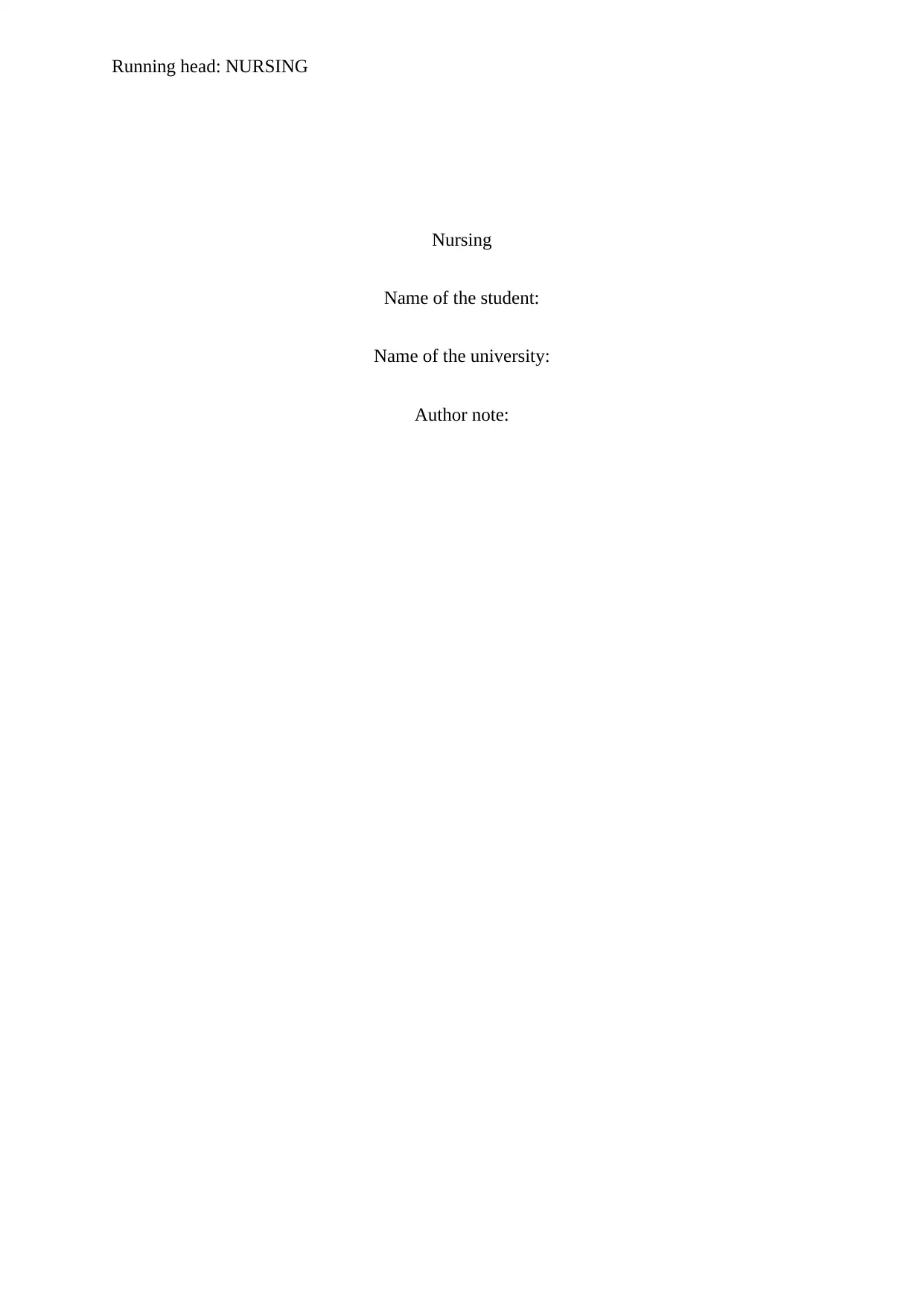
Running head: NURSING
Nursing
Name of the student:
Name of the university:
Author note:
Nursing
Name of the student:
Name of the university:
Author note:
Paraphrase This Document
Need a fresh take? Get an instant paraphrase of this document with our AI Paraphraser
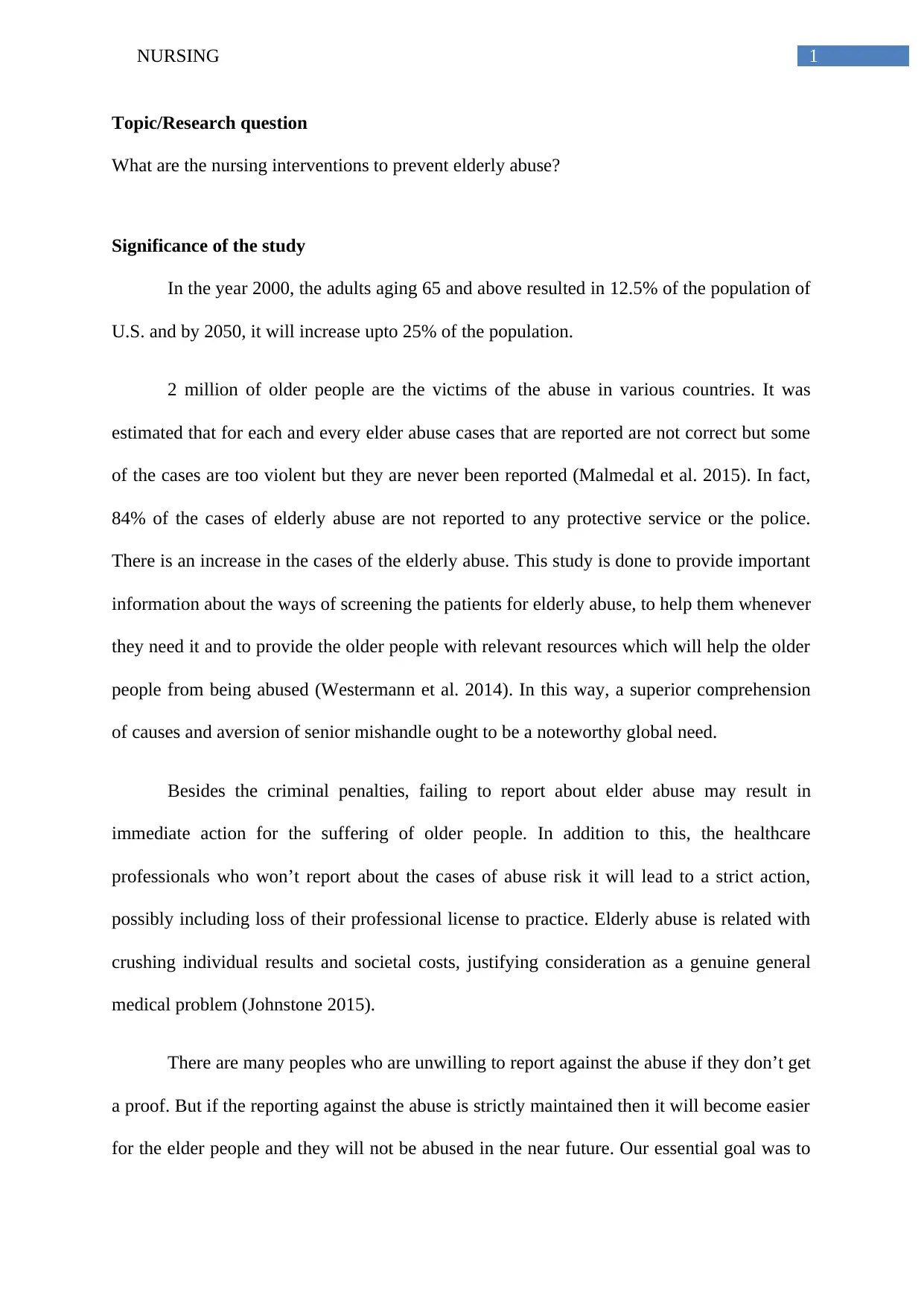
1NURSING
Topic/Research question
What are the nursing interventions to prevent elderly abuse?
Significance of the study
In the year 2000, the adults aging 65 and above resulted in 12.5% of the population of
U.S. and by 2050, it will increase upto 25% of the population.
2 million of older people are the victims of the abuse in various countries. It was
estimated that for each and every elder abuse cases that are reported are not correct but some
of the cases are too violent but they are never been reported (Malmedal et al. 2015). In fact,
84% of the cases of elderly abuse are not reported to any protective service or the police.
There is an increase in the cases of the elderly abuse. This study is done to provide important
information about the ways of screening the patients for elderly abuse, to help them whenever
they need it and to provide the older people with relevant resources which will help the older
people from being abused (Westermann et al. 2014). In this way, a superior comprehension
of causes and aversion of senior mishandle ought to be a noteworthy global need.
Besides the criminal penalties, failing to report about elder abuse may result in
immediate action for the suffering of older people. In addition to this, the healthcare
professionals who won’t report about the cases of abuse risk it will lead to a strict action,
possibly including loss of their professional license to practice. Elderly abuse is related with
crushing individual results and societal costs, justifying consideration as a genuine general
medical problem (Johnstone 2015).
There are many peoples who are unwilling to report against the abuse if they don’t get
a proof. But if the reporting against the abuse is strictly maintained then it will become easier
for the elder people and they will not be abused in the near future. Our essential goal was to
Topic/Research question
What are the nursing interventions to prevent elderly abuse?
Significance of the study
In the year 2000, the adults aging 65 and above resulted in 12.5% of the population of
U.S. and by 2050, it will increase upto 25% of the population.
2 million of older people are the victims of the abuse in various countries. It was
estimated that for each and every elder abuse cases that are reported are not correct but some
of the cases are too violent but they are never been reported (Malmedal et al. 2015). In fact,
84% of the cases of elderly abuse are not reported to any protective service or the police.
There is an increase in the cases of the elderly abuse. This study is done to provide important
information about the ways of screening the patients for elderly abuse, to help them whenever
they need it and to provide the older people with relevant resources which will help the older
people from being abused (Westermann et al. 2014). In this way, a superior comprehension
of causes and aversion of senior mishandle ought to be a noteworthy global need.
Besides the criminal penalties, failing to report about elder abuse may result in
immediate action for the suffering of older people. In addition to this, the healthcare
professionals who won’t report about the cases of abuse risk it will lead to a strict action,
possibly including loss of their professional license to practice. Elderly abuse is related with
crushing individual results and societal costs, justifying consideration as a genuine general
medical problem (Johnstone 2015).
There are many peoples who are unwilling to report against the abuse if they don’t get
a proof. But if the reporting against the abuse is strictly maintained then it will become easier
for the elder people and they will not be abused in the near future. Our essential goal was to
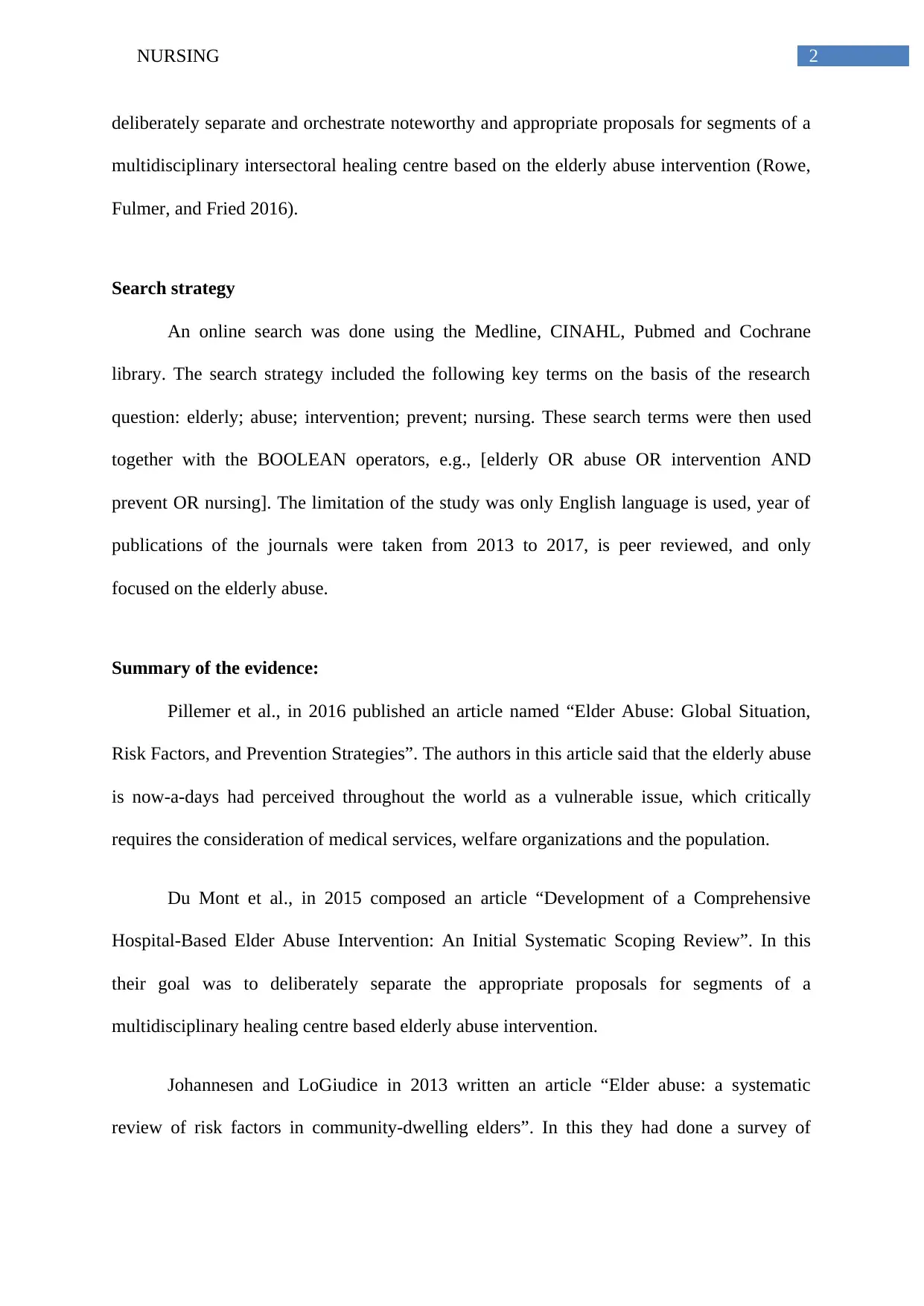
2NURSING
deliberately separate and orchestrate noteworthy and appropriate proposals for segments of a
multidisciplinary intersectoral healing centre based on the elderly abuse intervention (Rowe,
Fulmer, and Fried 2016).
Search strategy
An online search was done using the Medline, CINAHL, Pubmed and Cochrane
library. The search strategy included the following key terms on the basis of the research
question: elderly; abuse; intervention; prevent; nursing. These search terms were then used
together with the BOOLEAN operators, e.g., [elderly OR abuse OR intervention AND
prevent OR nursing]. The limitation of the study was only English language is used, year of
publications of the journals were taken from 2013 to 2017, is peer reviewed, and only
focused on the elderly abuse.
Summary of the evidence:
Pillemer et al., in 2016 published an article named “Elder Abuse: Global Situation,
Risk Factors, and Prevention Strategies”. The authors in this article said that the elderly abuse
is now-a-days had perceived throughout the world as a vulnerable issue, which critically
requires the consideration of medical services, welfare organizations and the population.
Du Mont et al., in 2015 composed an article “Development of a Comprehensive
Hospital-Based Elder Abuse Intervention: An Initial Systematic Scoping Review”. In this
their goal was to deliberately separate the appropriate proposals for segments of a
multidisciplinary healing centre based elderly abuse intervention.
Johannesen and LoGiudice in 2013 written an article “Elder abuse: a systematic
review of risk factors in community-dwelling elders”. In this they had done a survey of
deliberately separate and orchestrate noteworthy and appropriate proposals for segments of a
multidisciplinary intersectoral healing centre based on the elderly abuse intervention (Rowe,
Fulmer, and Fried 2016).
Search strategy
An online search was done using the Medline, CINAHL, Pubmed and Cochrane
library. The search strategy included the following key terms on the basis of the research
question: elderly; abuse; intervention; prevent; nursing. These search terms were then used
together with the BOOLEAN operators, e.g., [elderly OR abuse OR intervention AND
prevent OR nursing]. The limitation of the study was only English language is used, year of
publications of the journals were taken from 2013 to 2017, is peer reviewed, and only
focused on the elderly abuse.
Summary of the evidence:
Pillemer et al., in 2016 published an article named “Elder Abuse: Global Situation,
Risk Factors, and Prevention Strategies”. The authors in this article said that the elderly abuse
is now-a-days had perceived throughout the world as a vulnerable issue, which critically
requires the consideration of medical services, welfare organizations and the population.
Du Mont et al., in 2015 composed an article “Development of a Comprehensive
Hospital-Based Elder Abuse Intervention: An Initial Systematic Scoping Review”. In this
their goal was to deliberately separate the appropriate proposals for segments of a
multidisciplinary healing centre based elderly abuse intervention.
Johannesen and LoGiudice in 2013 written an article “Elder abuse: a systematic
review of risk factors in community-dwelling elders”. In this they had done a survey of
⊘ This is a preview!⊘
Do you want full access?
Subscribe today to unlock all pages.

Trusted by 1+ million students worldwide

3NURSING
factors of risk for abuse in the elderly peoples, as an initial move towards investigating the
utilization of the clinical structure.
Critical review of the evidence
Elder Abuse: Global Situation, Risk Factors, and Prevention Strategies (Pillemer et al.
2016)
Senior abuse is presently perceived globally as an inescapable and developing issue,
critically requiring the consideration of medicinal services frameworks, social welfare
organizations, policymakers, and the overall population. Reports from the World Health
Organization, United Nations, and other universal bodies have unmistakably included senior
manhandle and featured the scope of destructive exercises subsumed under this rubric all
through the world(Pillemer et al. 2016). With a worldwide blast in the more seasoned grown-
up populace, senior manhandle is required to wind up noticeably a significantly all the more
squeezing issue, influencing a great many people around the world. Elderly abuse is related
with crushing individual results and societal costs, justifying consideration as a genuine
general medical problem. In this article, we give an outline of worldwide issues in the field of
senior mishandle, with an emphasis on counteractive action. This article gives a checking
audit of key issues in the field from a worldwide point of view (Baker et al. 2016). By
drawing basically on populace based examinations, this checking audit gave a more
legitimate and dependable blend of current information about predominance and hazard
factors than has been accessible. This accentuation is suitable in light of the fact that senior
manhandle is likely the most broad issue of more seasoned individuals that is to a great extent
preventable (not at all like numerous infection states of maturity). In this way, a superior
comprehension of causes and aversion of senior mishandle ought to be a noteworthy global
need. Luckily, an enhancing worldwide logical writing has gone with this developing
factors of risk for abuse in the elderly peoples, as an initial move towards investigating the
utilization of the clinical structure.
Critical review of the evidence
Elder Abuse: Global Situation, Risk Factors, and Prevention Strategies (Pillemer et al.
2016)
Senior abuse is presently perceived globally as an inescapable and developing issue,
critically requiring the consideration of medicinal services frameworks, social welfare
organizations, policymakers, and the overall population. Reports from the World Health
Organization, United Nations, and other universal bodies have unmistakably included senior
manhandle and featured the scope of destructive exercises subsumed under this rubric all
through the world(Pillemer et al. 2016). With a worldwide blast in the more seasoned grown-
up populace, senior manhandle is required to wind up noticeably a significantly all the more
squeezing issue, influencing a great many people around the world. Elderly abuse is related
with crushing individual results and societal costs, justifying consideration as a genuine
general medical problem. In this article, we give an outline of worldwide issues in the field of
senior mishandle, with an emphasis on counteractive action. This article gives a checking
audit of key issues in the field from a worldwide point of view (Baker et al. 2016). By
drawing basically on populace based examinations, this checking audit gave a more
legitimate and dependable blend of current information about predominance and hazard
factors than has been accessible. This accentuation is suitable in light of the fact that senior
manhandle is likely the most broad issue of more seasoned individuals that is to a great extent
preventable (not at all like numerous infection states of maturity). In this way, a superior
comprehension of causes and aversion of senior mishandle ought to be a noteworthy global
need. Luckily, an enhancing worldwide logical writing has gone with this developing
Paraphrase This Document
Need a fresh take? Get an instant paraphrase of this document with our AI Paraphraser
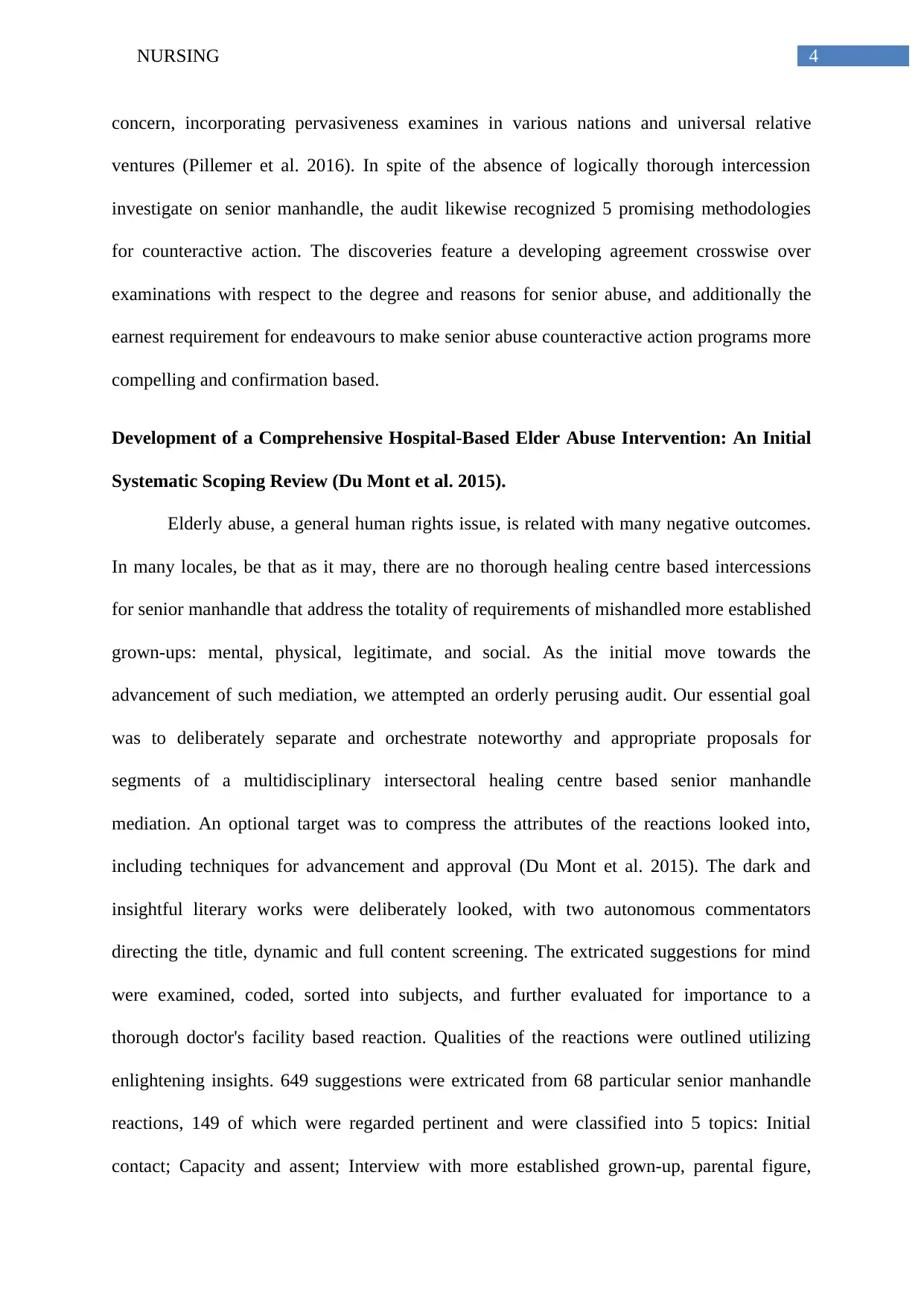
4NURSING
concern, incorporating pervasiveness examines in various nations and universal relative
ventures (Pillemer et al. 2016). In spite of the absence of logically thorough intercession
investigate on senior manhandle, the audit likewise recognized 5 promising methodologies
for counteractive action. The discoveries feature a developing agreement crosswise over
examinations with respect to the degree and reasons for senior abuse, and additionally the
earnest requirement for endeavours to make senior abuse counteractive action programs more
compelling and confirmation based.
Development of a Comprehensive Hospital-Based Elder Abuse Intervention: An Initial
Systematic Scoping Review (Du Mont et al. 2015).
Elderly abuse, a general human rights issue, is related with many negative outcomes.
In many locales, be that as it may, there are no thorough healing centre based intercessions
for senior manhandle that address the totality of requirements of mishandled more established
grown-ups: mental, physical, legitimate, and social. As the initial move towards the
advancement of such mediation, we attempted an orderly perusing audit. Our essential goal
was to deliberately separate and orchestrate noteworthy and appropriate proposals for
segments of a multidisciplinary intersectoral healing centre based senior manhandle
mediation. An optional target was to compress the attributes of the reactions looked into,
including techniques for advancement and approval (Du Mont et al. 2015). The dark and
insightful literary works were deliberately looked, with two autonomous commentators
directing the title, dynamic and full content screening. The extricated suggestions for mind
were examined, coded, sorted into subjects, and further evaluated for importance to a
thorough doctor's facility based reaction. Qualities of the reactions were outlined utilizing
enlightening insights. 649 suggestions were extricated from 68 particular senior manhandle
reactions, 149 of which were regarded pertinent and were classified into 5 topics: Initial
contact; Capacity and assent; Interview with more established grown-up, parental figure,
concern, incorporating pervasiveness examines in various nations and universal relative
ventures (Pillemer et al. 2016). In spite of the absence of logically thorough intercession
investigate on senior manhandle, the audit likewise recognized 5 promising methodologies
for counteractive action. The discoveries feature a developing agreement crosswise over
examinations with respect to the degree and reasons for senior abuse, and additionally the
earnest requirement for endeavours to make senior abuse counteractive action programs more
compelling and confirmation based.
Development of a Comprehensive Hospital-Based Elder Abuse Intervention: An Initial
Systematic Scoping Review (Du Mont et al. 2015).
Elderly abuse, a general human rights issue, is related with many negative outcomes.
In many locales, be that as it may, there are no thorough healing centre based intercessions
for senior manhandle that address the totality of requirements of mishandled more established
grown-ups: mental, physical, legitimate, and social. As the initial move towards the
advancement of such mediation, we attempted an orderly perusing audit. Our essential goal
was to deliberately separate and orchestrate noteworthy and appropriate proposals for
segments of a multidisciplinary intersectoral healing centre based senior manhandle
mediation. An optional target was to compress the attributes of the reactions looked into,
including techniques for advancement and approval (Du Mont et al. 2015). The dark and
insightful literary works were deliberately looked, with two autonomous commentators
directing the title, dynamic and full content screening. The extricated suggestions for mind
were examined, coded, sorted into subjects, and further evaluated for importance to a
thorough doctor's facility based reaction. Qualities of the reactions were outlined utilizing
enlightening insights. 649 suggestions were extricated from 68 particular senior manhandle
reactions, 149 of which were regarded pertinent and were classified into 5 topics: Initial
contact; Capacity and assent; Interview with more established grown-up, parental figure,
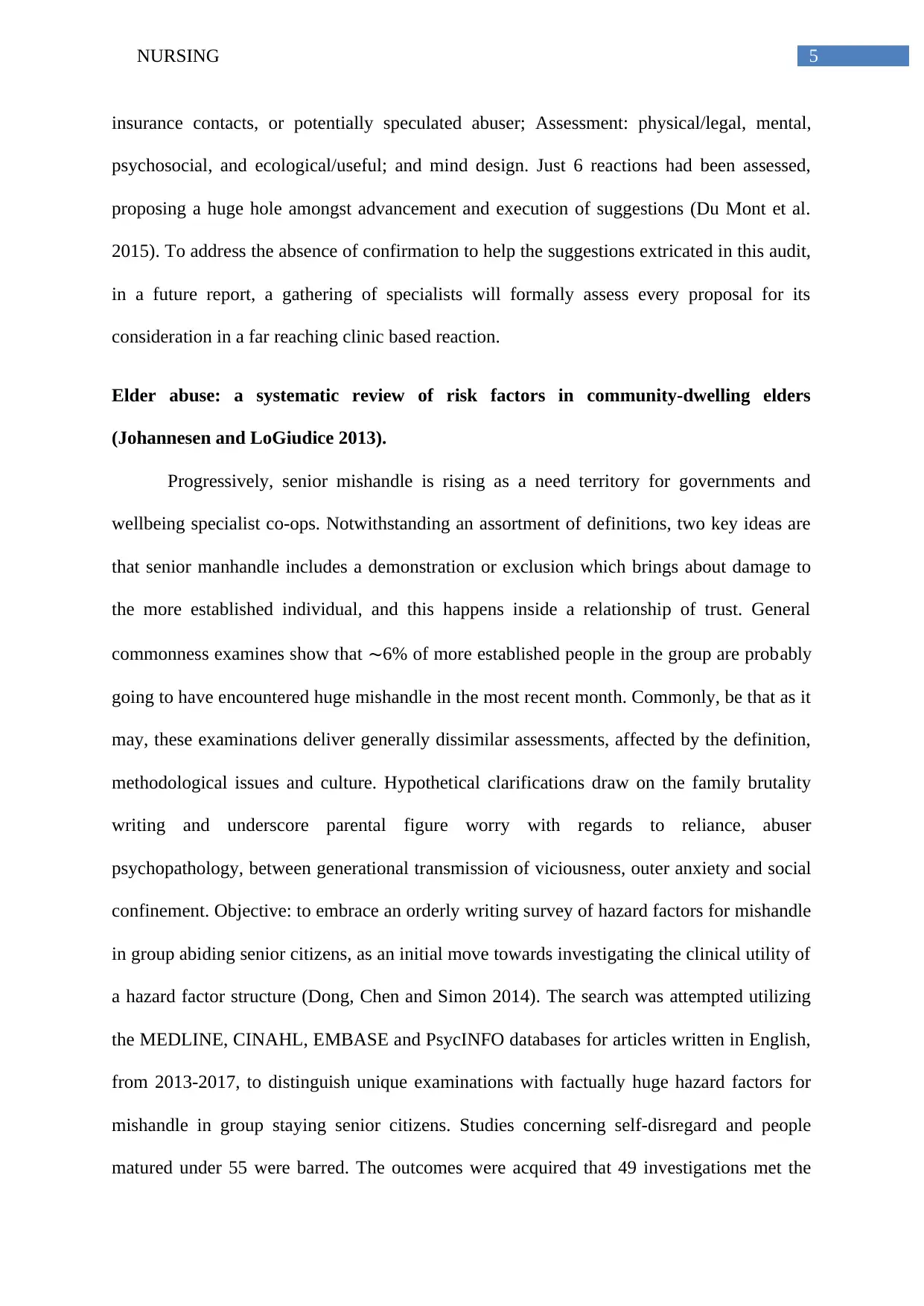
5NURSING
insurance contacts, or potentially speculated abuser; Assessment: physical/legal, mental,
psychosocial, and ecological/useful; and mind design. Just 6 reactions had been assessed,
proposing a huge hole amongst advancement and execution of suggestions (Du Mont et al.
2015). To address the absence of confirmation to help the suggestions extricated in this audit,
in a future report, a gathering of specialists will formally assess every proposal for its
consideration in a far reaching clinic based reaction.
Elder abuse: a systematic review of risk factors in community-dwelling elders
(Johannesen and LoGiudice 2013).
Progressively, senior mishandle is rising as a need territory for governments and
wellbeing specialist co-ops. Notwithstanding an assortment of definitions, two key ideas are
that senior manhandle includes a demonstration or exclusion which brings about damage to
the more established individual, and this happens inside a relationship of trust. General
commonness examines show that ∼6% of more established people in the group are probably
going to have encountered huge mishandle in the most recent month. Commonly, be that as it
may, these examinations deliver generally dissimilar assessments, affected by the definition,
methodological issues and culture. Hypothetical clarifications draw on the family brutality
writing and underscore parental figure worry with regards to reliance, abuser
psychopathology, between generational transmission of viciousness, outer anxiety and social
confinement. Objective: to embrace an orderly writing survey of hazard factors for mishandle
in group abiding senior citizens, as an initial move towards investigating the clinical utility of
a hazard factor structure (Dong, Chen and Simon 2014). The search was attempted utilizing
the MEDLINE, CINAHL, EMBASE and PsycINFO databases for articles written in English,
from 2013-2017, to distinguish unique examinations with factually huge hazard factors for
mishandle in group staying senior citizens. Studies concerning self-disregard and people
matured under 55 were barred. The outcomes were acquired that 49 investigations met the
insurance contacts, or potentially speculated abuser; Assessment: physical/legal, mental,
psychosocial, and ecological/useful; and mind design. Just 6 reactions had been assessed,
proposing a huge hole amongst advancement and execution of suggestions (Du Mont et al.
2015). To address the absence of confirmation to help the suggestions extricated in this audit,
in a future report, a gathering of specialists will formally assess every proposal for its
consideration in a far reaching clinic based reaction.
Elder abuse: a systematic review of risk factors in community-dwelling elders
(Johannesen and LoGiudice 2013).
Progressively, senior mishandle is rising as a need territory for governments and
wellbeing specialist co-ops. Notwithstanding an assortment of definitions, two key ideas are
that senior manhandle includes a demonstration or exclusion which brings about damage to
the more established individual, and this happens inside a relationship of trust. General
commonness examines show that ∼6% of more established people in the group are probably
going to have encountered huge mishandle in the most recent month. Commonly, be that as it
may, these examinations deliver generally dissimilar assessments, affected by the definition,
methodological issues and culture. Hypothetical clarifications draw on the family brutality
writing and underscore parental figure worry with regards to reliance, abuser
psychopathology, between generational transmission of viciousness, outer anxiety and social
confinement. Objective: to embrace an orderly writing survey of hazard factors for mishandle
in group abiding senior citizens, as an initial move towards investigating the clinical utility of
a hazard factor structure (Dong, Chen and Simon 2014). The search was attempted utilizing
the MEDLINE, CINAHL, EMBASE and PsycINFO databases for articles written in English,
from 2013-2017, to distinguish unique examinations with factually huge hazard factors for
mishandle in group staying senior citizens. Studies concerning self-disregard and people
matured under 55 were barred. The outcomes were acquired that 49 investigations met the
⊘ This is a preview!⊘
Do you want full access?
Subscribe today to unlock all pages.

Trusted by 1+ million students worldwide
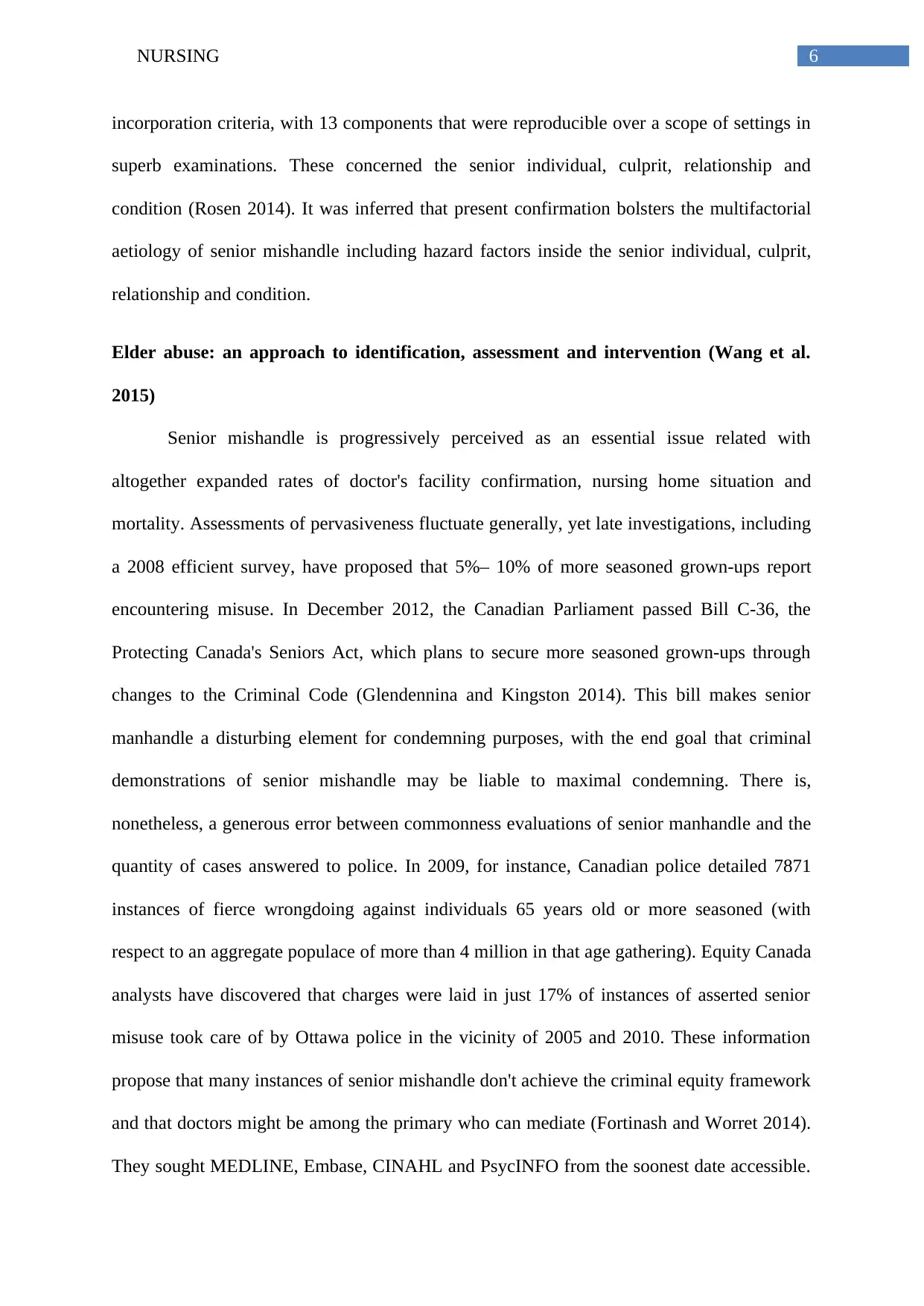
6NURSING
incorporation criteria, with 13 components that were reproducible over a scope of settings in
superb examinations. These concerned the senior individual, culprit, relationship and
condition (Rosen 2014). It was inferred that present confirmation bolsters the multifactorial
aetiology of senior mishandle including hazard factors inside the senior individual, culprit,
relationship and condition.
Elder abuse: an approach to identification, assessment and intervention (Wang et al.
2015)
Senior mishandle is progressively perceived as an essential issue related with
altogether expanded rates of doctor's facility confirmation, nursing home situation and
mortality. Assessments of pervasiveness fluctuate generally, yet late investigations, including
a 2008 efficient survey, have proposed that 5%– 10% of more seasoned grown-ups report
encountering misuse. In December 2012, the Canadian Parliament passed Bill C-36, the
Protecting Canada's Seniors Act, which plans to secure more seasoned grown-ups through
changes to the Criminal Code (Glendennina and Kingston 2014). This bill makes senior
manhandle a disturbing element for condemning purposes, with the end goal that criminal
demonstrations of senior mishandle may be liable to maximal condemning. There is,
nonetheless, a generous error between commonness evaluations of senior manhandle and the
quantity of cases answered to police. In 2009, for instance, Canadian police detailed 7871
instances of fierce wrongdoing against individuals 65 years old or more seasoned (with
respect to an aggregate populace of more than 4 million in that age gathering). Equity Canada
analysts have discovered that charges were laid in just 17% of instances of asserted senior
misuse took care of by Ottawa police in the vicinity of 2005 and 2010. These information
propose that many instances of senior mishandle don't achieve the criminal equity framework
and that doctors might be among the primary who can mediate (Fortinash and Worret 2014).
They sought MEDLINE, Embase, CINAHL and PsycINFO from the soonest date accessible.
incorporation criteria, with 13 components that were reproducible over a scope of settings in
superb examinations. These concerned the senior individual, culprit, relationship and
condition (Rosen 2014). It was inferred that present confirmation bolsters the multifactorial
aetiology of senior mishandle including hazard factors inside the senior individual, culprit,
relationship and condition.
Elder abuse: an approach to identification, assessment and intervention (Wang et al.
2015)
Senior mishandle is progressively perceived as an essential issue related with
altogether expanded rates of doctor's facility confirmation, nursing home situation and
mortality. Assessments of pervasiveness fluctuate generally, yet late investigations, including
a 2008 efficient survey, have proposed that 5%– 10% of more seasoned grown-ups report
encountering misuse. In December 2012, the Canadian Parliament passed Bill C-36, the
Protecting Canada's Seniors Act, which plans to secure more seasoned grown-ups through
changes to the Criminal Code (Glendennina and Kingston 2014). This bill makes senior
manhandle a disturbing element for condemning purposes, with the end goal that criminal
demonstrations of senior mishandle may be liable to maximal condemning. There is,
nonetheless, a generous error between commonness evaluations of senior manhandle and the
quantity of cases answered to police. In 2009, for instance, Canadian police detailed 7871
instances of fierce wrongdoing against individuals 65 years old or more seasoned (with
respect to an aggregate populace of more than 4 million in that age gathering). Equity Canada
analysts have discovered that charges were laid in just 17% of instances of asserted senior
misuse took care of by Ottawa police in the vicinity of 2005 and 2010. These information
propose that many instances of senior mishandle don't achieve the criminal equity framework
and that doctors might be among the primary who can mediate (Fortinash and Worret 2014).
They sought MEDLINE, Embase, CINAHL and PsycINFO from the soonest date accessible.
Paraphrase This Document
Need a fresh take? Get an instant paraphrase of this document with our AI Paraphraser
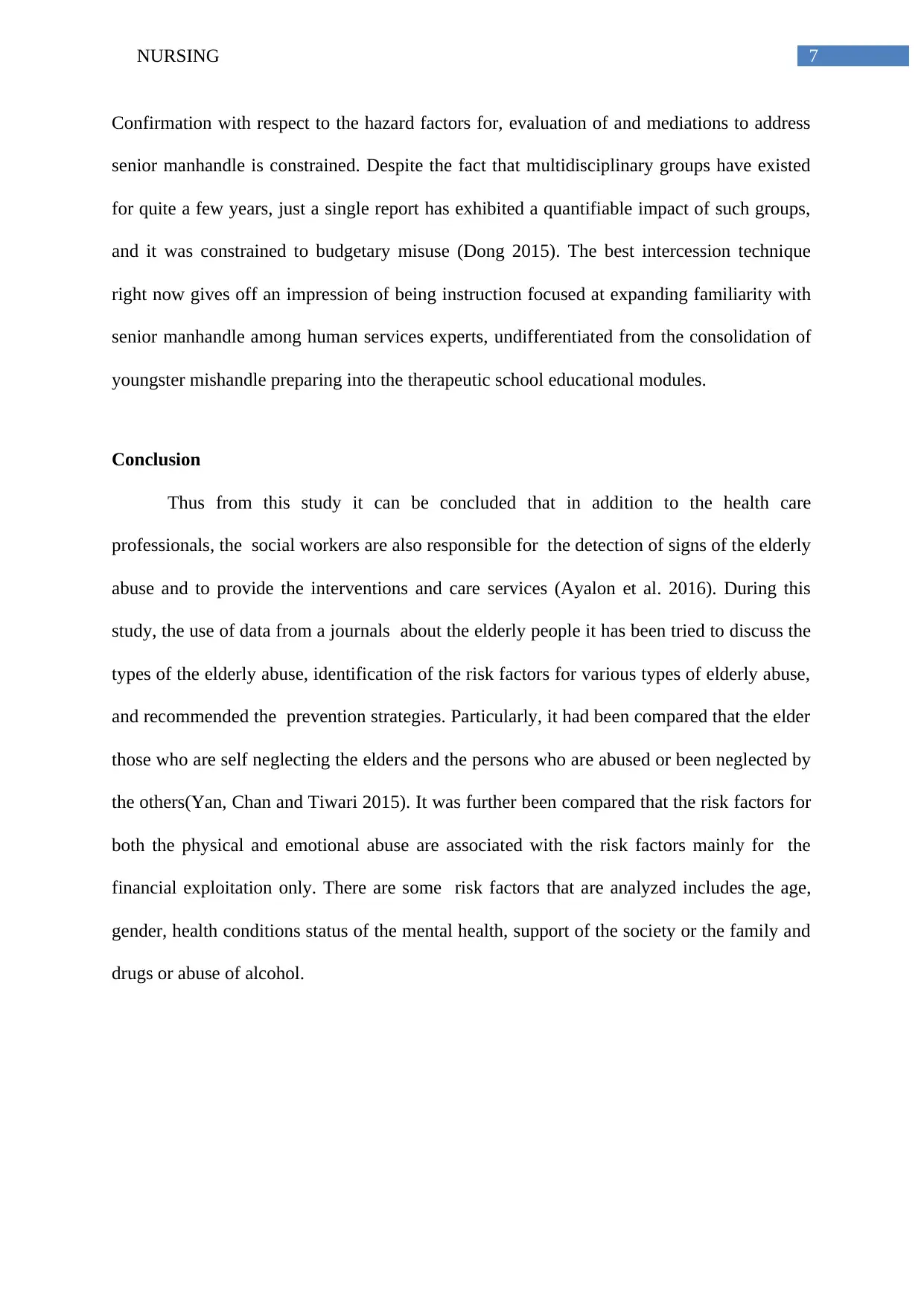
7NURSING
Confirmation with respect to the hazard factors for, evaluation of and mediations to address
senior manhandle is constrained. Despite the fact that multidisciplinary groups have existed
for quite a few years, just a single report has exhibited a quantifiable impact of such groups,
and it was constrained to budgetary misuse (Dong 2015). The best intercession technique
right now gives off an impression of being instruction focused at expanding familiarity with
senior manhandle among human services experts, undifferentiated from the consolidation of
youngster mishandle preparing into the therapeutic school educational modules.
Conclusion
Thus from this study it can be concluded that in addition to the health care
professionals, the social workers are also responsible for the detection of signs of the elderly
abuse and to provide the interventions and care services (Ayalon et al. 2016). During this
study, the use of data from a journals about the elderly people it has been tried to discuss the
types of the elderly abuse, identification of the risk factors for various types of elderly abuse,
and recommended the prevention strategies. Particularly, it had been compared that the elder
those who are self neglecting the elders and the persons who are abused or been neglected by
the others(Yan, Chan and Tiwari 2015). It was further been compared that the risk factors for
both the physical and emotional abuse are associated with the risk factors mainly for the
financial exploitation only. There are some risk factors that are analyzed includes the age,
gender, health conditions status of the mental health, support of the society or the family and
drugs or abuse of alcohol.
Confirmation with respect to the hazard factors for, evaluation of and mediations to address
senior manhandle is constrained. Despite the fact that multidisciplinary groups have existed
for quite a few years, just a single report has exhibited a quantifiable impact of such groups,
and it was constrained to budgetary misuse (Dong 2015). The best intercession technique
right now gives off an impression of being instruction focused at expanding familiarity with
senior manhandle among human services experts, undifferentiated from the consolidation of
youngster mishandle preparing into the therapeutic school educational modules.
Conclusion
Thus from this study it can be concluded that in addition to the health care
professionals, the social workers are also responsible for the detection of signs of the elderly
abuse and to provide the interventions and care services (Ayalon et al. 2016). During this
study, the use of data from a journals about the elderly people it has been tried to discuss the
types of the elderly abuse, identification of the risk factors for various types of elderly abuse,
and recommended the prevention strategies. Particularly, it had been compared that the elder
those who are self neglecting the elders and the persons who are abused or been neglected by
the others(Yan, Chan and Tiwari 2015). It was further been compared that the risk factors for
both the physical and emotional abuse are associated with the risk factors mainly for the
financial exploitation only. There are some risk factors that are analyzed includes the age,
gender, health conditions status of the mental health, support of the society or the family and
drugs or abuse of alcohol.
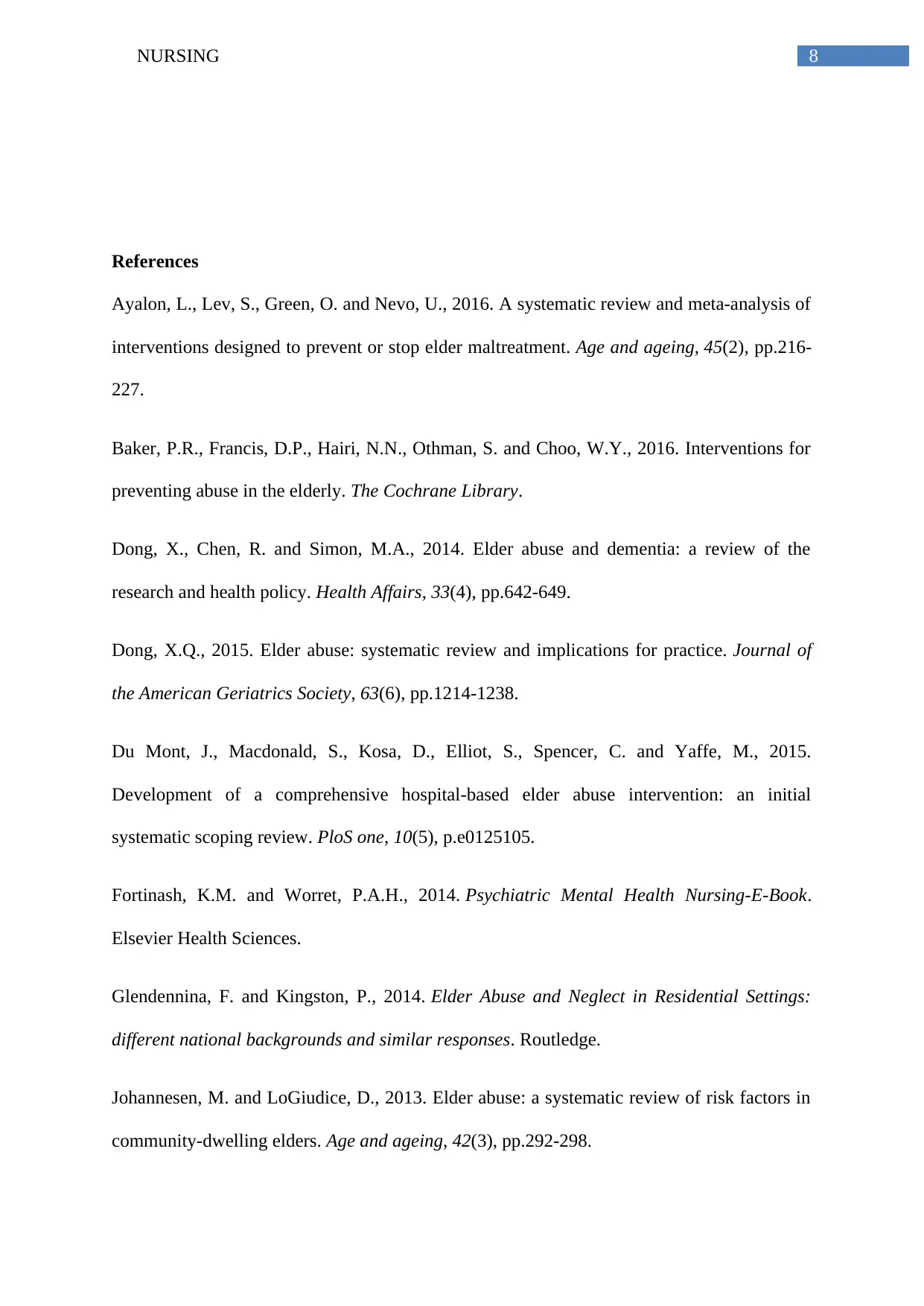
8NURSING
References
Ayalon, L., Lev, S., Green, O. and Nevo, U., 2016. A systematic review and meta-analysis of
interventions designed to prevent or stop elder maltreatment. Age and ageing, 45(2), pp.216-
227.
Baker, P.R., Francis, D.P., Hairi, N.N., Othman, S. and Choo, W.Y., 2016. Interventions for
preventing abuse in the elderly. The Cochrane Library.
Dong, X., Chen, R. and Simon, M.A., 2014. Elder abuse and dementia: a review of the
research and health policy. Health Affairs, 33(4), pp.642-649.
Dong, X.Q., 2015. Elder abuse: systematic review and implications for practice. Journal of
the American Geriatrics Society, 63(6), pp.1214-1238.
Du Mont, J., Macdonald, S., Kosa, D., Elliot, S., Spencer, C. and Yaffe, M., 2015.
Development of a comprehensive hospital-based elder abuse intervention: an initial
systematic scoping review. PloS one, 10(5), p.e0125105.
Fortinash, K.M. and Worret, P.A.H., 2014. Psychiatric Mental Health Nursing-E-Book.
Elsevier Health Sciences.
Glendennina, F. and Kingston, P., 2014. Elder Abuse and Neglect in Residential Settings:
different national backgrounds and similar responses. Routledge.
Johannesen, M. and LoGiudice, D., 2013. Elder abuse: a systematic review of risk factors in
community-dwelling elders. Age and ageing, 42(3), pp.292-298.
References
Ayalon, L., Lev, S., Green, O. and Nevo, U., 2016. A systematic review and meta-analysis of
interventions designed to prevent or stop elder maltreatment. Age and ageing, 45(2), pp.216-
227.
Baker, P.R., Francis, D.P., Hairi, N.N., Othman, S. and Choo, W.Y., 2016. Interventions for
preventing abuse in the elderly. The Cochrane Library.
Dong, X., Chen, R. and Simon, M.A., 2014. Elder abuse and dementia: a review of the
research and health policy. Health Affairs, 33(4), pp.642-649.
Dong, X.Q., 2015. Elder abuse: systematic review and implications for practice. Journal of
the American Geriatrics Society, 63(6), pp.1214-1238.
Du Mont, J., Macdonald, S., Kosa, D., Elliot, S., Spencer, C. and Yaffe, M., 2015.
Development of a comprehensive hospital-based elder abuse intervention: an initial
systematic scoping review. PloS one, 10(5), p.e0125105.
Fortinash, K.M. and Worret, P.A.H., 2014. Psychiatric Mental Health Nursing-E-Book.
Elsevier Health Sciences.
Glendennina, F. and Kingston, P., 2014. Elder Abuse and Neglect in Residential Settings:
different national backgrounds and similar responses. Routledge.
Johannesen, M. and LoGiudice, D., 2013. Elder abuse: a systematic review of risk factors in
community-dwelling elders. Age and ageing, 42(3), pp.292-298.
⊘ This is a preview!⊘
Do you want full access?
Subscribe today to unlock all pages.

Trusted by 1+ million students worldwide
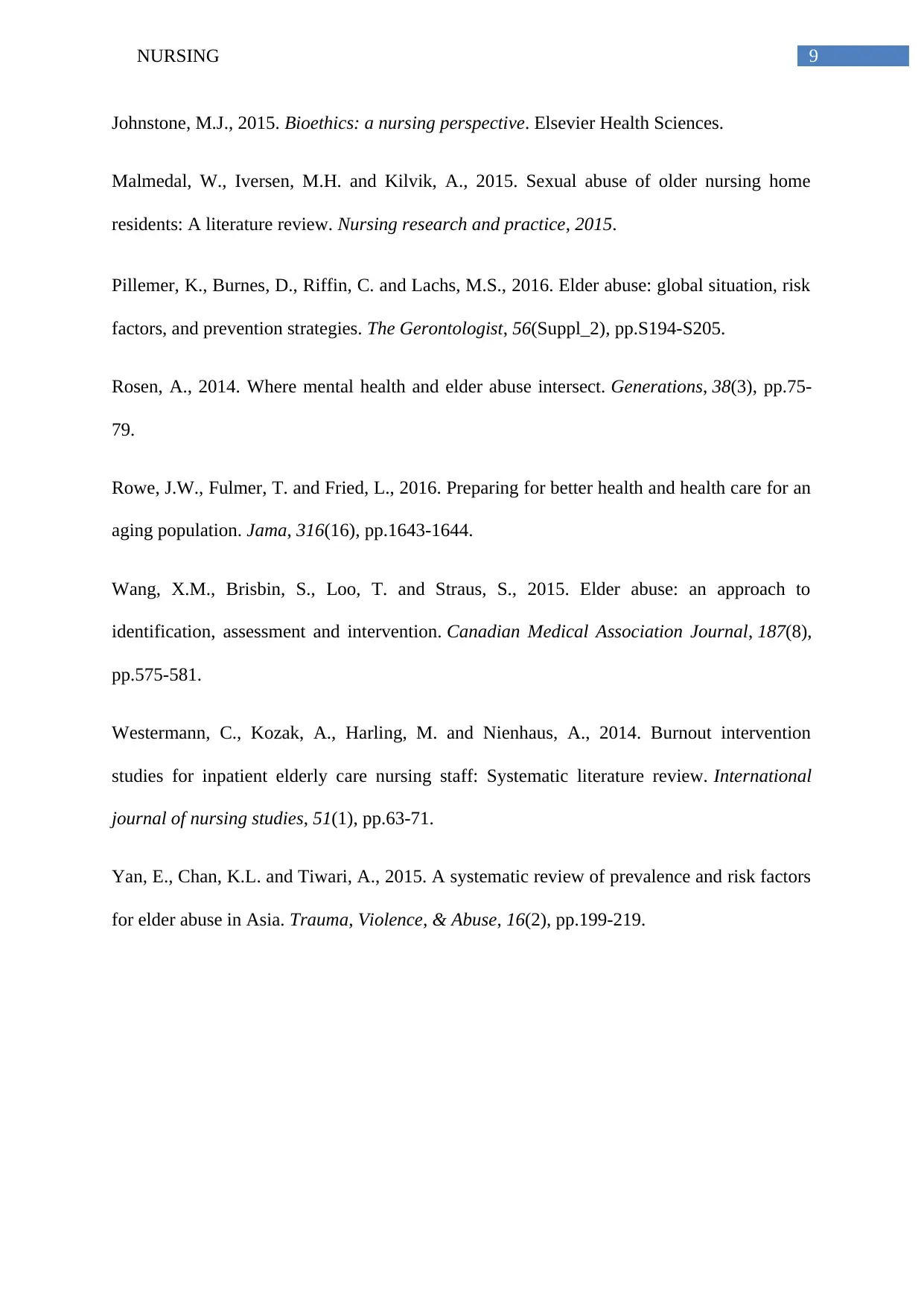
9NURSING
Johnstone, M.J., 2015. Bioethics: a nursing perspective. Elsevier Health Sciences.
Malmedal, W., Iversen, M.H. and Kilvik, A., 2015. Sexual abuse of older nursing home
residents: A literature review. Nursing research and practice, 2015.
Pillemer, K., Burnes, D., Riffin, C. and Lachs, M.S., 2016. Elder abuse: global situation, risk
factors, and prevention strategies. The Gerontologist, 56(Suppl_2), pp.S194-S205.
Rosen, A., 2014. Where mental health and elder abuse intersect. Generations, 38(3), pp.75-
79.
Rowe, J.W., Fulmer, T. and Fried, L., 2016. Preparing for better health and health care for an
aging population. Jama, 316(16), pp.1643-1644.
Wang, X.M., Brisbin, S., Loo, T. and Straus, S., 2015. Elder abuse: an approach to
identification, assessment and intervention. Canadian Medical Association Journal, 187(8),
pp.575-581.
Westermann, C., Kozak, A., Harling, M. and Nienhaus, A., 2014. Burnout intervention
studies for inpatient elderly care nursing staff: Systematic literature review. International
journal of nursing studies, 51(1), pp.63-71.
Yan, E., Chan, K.L. and Tiwari, A., 2015. A systematic review of prevalence and risk factors
for elder abuse in Asia. Trauma, Violence, & Abuse, 16(2), pp.199-219.
Johnstone, M.J., 2015. Bioethics: a nursing perspective. Elsevier Health Sciences.
Malmedal, W., Iversen, M.H. and Kilvik, A., 2015. Sexual abuse of older nursing home
residents: A literature review. Nursing research and practice, 2015.
Pillemer, K., Burnes, D., Riffin, C. and Lachs, M.S., 2016. Elder abuse: global situation, risk
factors, and prevention strategies. The Gerontologist, 56(Suppl_2), pp.S194-S205.
Rosen, A., 2014. Where mental health and elder abuse intersect. Generations, 38(3), pp.75-
79.
Rowe, J.W., Fulmer, T. and Fried, L., 2016. Preparing for better health and health care for an
aging population. Jama, 316(16), pp.1643-1644.
Wang, X.M., Brisbin, S., Loo, T. and Straus, S., 2015. Elder abuse: an approach to
identification, assessment and intervention. Canadian Medical Association Journal, 187(8),
pp.575-581.
Westermann, C., Kozak, A., Harling, M. and Nienhaus, A., 2014. Burnout intervention
studies for inpatient elderly care nursing staff: Systematic literature review. International
journal of nursing studies, 51(1), pp.63-71.
Yan, E., Chan, K.L. and Tiwari, A., 2015. A systematic review of prevalence and risk factors
for elder abuse in Asia. Trauma, Violence, & Abuse, 16(2), pp.199-219.
1 out of 10
Related Documents
Your All-in-One AI-Powered Toolkit for Academic Success.
+13062052269
info@desklib.com
Available 24*7 on WhatsApp / Email
![[object Object]](/_next/static/media/star-bottom.7253800d.svg)
Unlock your academic potential
Copyright © 2020–2025 A2Z Services. All Rights Reserved. Developed and managed by ZUCOL.





